We independently evaluate all recommended products and services. Any products or services put forward appear in no particular order. If you click on links we provide, we may receive compensation.
Let me start this review off with an important piece of information: the knife we’re talking about today is out of production. It’s not available new anywhere I can find, and if you want one, you’ll have to find someone willing to sell theirs to you. It was discontinued in 2016 after the Caly line gradually dwindled down into near nonexistence, now only available as the longer Caly 3.5. This one is arguably the cream of the crop, featuring smooth carbon fiber scales and a very exotic blade – which we’ll get into in more detail later.

But why bother reviewing a knife that’s out of production? Well, the Spyderco Caly 3 (short for Calypso) was a mainstay in Spyderco’s primary lineup, and is a study in ergonomic consideration over aesthetics. It’s old and out of date in some ways, but in others it’s still state of the art for use. Not to say that Spyderco makes a lot of “all show, no go” knives (far from it) but the Caly 3 CF-ZDP is a case study in function over form that is still relevant to this day.
Key Specs: Spyderco Caly 3
The Blade
Okay, here’s the first interesting part of the Caly. What’s the blade steel? Well, which part of the blade? The Caly 3 CF-ZDP uses a laminated blade – the inner core is ZDP-189, and the outer shell is 420J2. Why make a blade out of different inner and outer layers of steel? Well, the theory is that you make the inner core out of a very hard, brittle steel, and the outer core out of a softer, more corrosion resistant steel gives you the best of both worlds: the high performance and edge retention of a very high-carbon steel on the cutting edge, and a softer more flexible spine prevents damage to the blade when you’re bearing down on it.
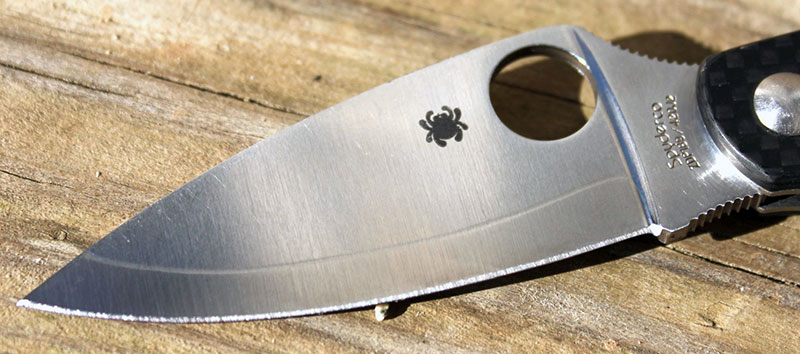
It’s relatively uncommon in the industry, primarily due to manufacturing expense (obviously!) as well as modern high-end steels offering a really good balance of performance and corrosion resistance. Other makers that have used laminate blades in folders are pretty much limited to Cold Steel (with their San Mai III) and Fallkniven, although Kershaw/ZT used a similar concept with their composite blades which meld a softer spine metal with a harder edge metal, like the dramatic ZT 0454.
The core steel- ZDP-189 – is a pretty exotic alloy made by Hitachi in Japan. It is extremely high carbon, 3.0%, meaning it’s about 3 times the carbon content of VG-10, and 30 times the carbon content of the outer layer of 420J2. Carbon is the primary determinant of edge retention and hardness in steel. Chromium is also high at 20%, which determines hardness and corrosion resistance. It also has a considerable amount of molybdenum, which increases strength and hardness as well as limits grain size in the steel to make for a finer edge.
ZDP is extremely hard steel, well above 60 Rockwell with how Spyderco heat treats it, and it holds an edge for an extremely long time – and is logically a total pain to sharpen. 420J2, the outer core, is a low-carbon steel with a pretty simple chemical makeup that yields a soft, highly corrosion resistant (stainless) steel. It’s a logical pairing.

Dimensions on the Caly 3 put it in the sweet spot of usability for me, with a 3” long blade with a 2.625” cutting edge owing to a forward finger choil. The blade itself is relatively narrow at 0.125” across the spine, and it’s full flat ground from the edge bevel to the spine so this blade is focused on slicing performance above toughness. The blade shape is a modified drop point, made especially tall to fit the trademark Spyderco thumb hole for opening.
There is no sharpening choil, so the Caly has a mild ‘beard’ where the sharpened edge meets the plunge line, which is a unique curved plunge starting from behind the thumb hole at the peak of the thumb ramp. The surface has a satin finish, and as the blade ages the two steels get slightly different patinas so it becomes easier to see the laminate line. It’s very interesting.
Deployment & Lockup
There’s not a ton to talk about here. Deployment is hands down the Caly 3’s weak point, at least when viewed through the lens of more modern knives. I don’t have anything against the thumb hole – I still believe in terms of the various opening methods (thumb studs, discs, nail nicks, flippers etc) it’s the easiest and most versatile. But the action of this knife is stiff and slow, and this knife was more than well broken in by the time I got my hands on it. One reason is that the knife lacks any washers – the blade and the stainless liners are high polished from the factory to reduce friction, but they are still in direct contact with each other, with gradually leaves “tracks” around the base of the blade where it rubs against the liners.
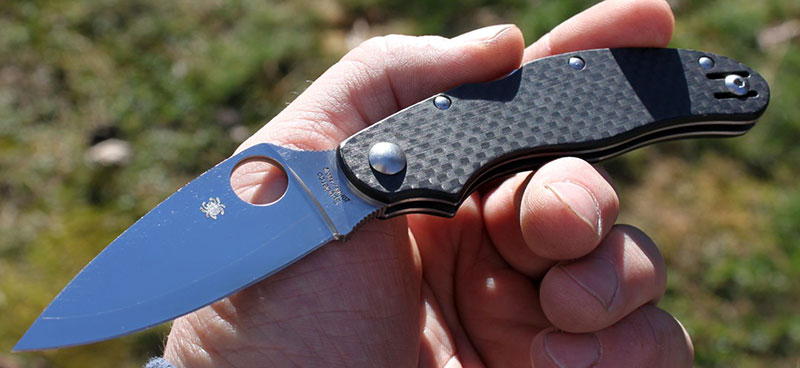
When new these knives are much smoother, but the action ages more poorly than a comparable knife with phosphor bronze washers, which are essentially self-lubricating. You can smooth the action out a bit with a few drops of lube, but it’s still a slow and deliberate opening. This isn’t a knife to please habitual fidgeters, being nearly impossible to “flick” open even for a veteran Spyderco nerd like myself. Closing can be done one handed but it’s tricky, with the thumb pressing the lock bar and the forefinger moving the blade closed, then repositioning the hand with the rest of your fingers out of the way to close it all the way.
Of course it can be argued that this is largely a matter of expectation – in the last ten years or so, knives have definitely shifted focus (at least some of them) to becoming adult fidget toys. I say that as a fan of adult fidget toys, and Spyderco makes some of the very best AFT’s out there. This just isn’t – and wasn’t designed as – one of them.

Lockup? Well, there’s no issues at all with lockup. Even without knowing the full history of my knife, which arrived to me well used with at least two previous owners, the lockup on this Caly 3 is perfect. The lockback is one of the most old-fashioned lock types, but I still love it for its simple effectiveness. This particular one is more of a mid-lock, and it features a Boye detent to prevent accidental lock release. It snaps into place with a reassuring click, and there’s zero blade play in any direction when it’s open. Spyderco uses a relatively strong spring to secure the lock, and it ensures reliable contact with the blade tang. As with any lockback, it’s important to periodically clean the inside of the knife out (with compressed air, preferably) to prevent the build-up of “crud” in the notch in the tang of the blade where the lock bar engages.
Features, Fit & Finish
Fit and finish on this knife is really amazing. It was produced in the Seki City Japan factory where the Delica/Endura line of knives is assembled, and it has several hallmarks of master craftsmanship. Most impressive to me is how the liners match up with the backspacer as well as the lock bar – you can pass your finger nail across the backspacer and both liners and cannot actually feel where the three pieces separate. The lock bar itself is nearly as flush as the backspacer, which is really amazing considering it moves. The stainless liners are also perfectly flush with the carbon fiber scales, which deserve to be stared at, at least for a little while.
They’re full carbon – not a G10 laminate – and they’re smooth to the touch, with a deep luster that’s unusual for the synthetic material to possess. The tang of the blade also lines up perfectly with the lock bar when open, and the curvature of the thumb ramp perfectly matches the lower portion of the scale that forms the finger choil when closed. The fit and finish on this knife is really stellar, even being several years old and having had several owners.
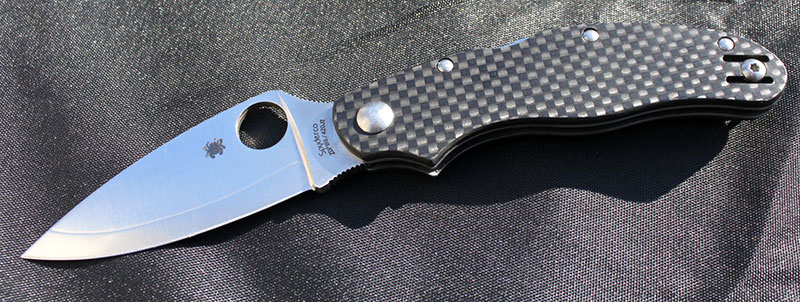
One thing that belies the age of this design is its construction: the Caly3 is pinned together with the exception of the pivot and the clip screw, so it cannot be disassembled (unless you’ve got a drill press and you like creating problems for yourself.) I really don’t like taking apart lockbacks, but I’d at least like the opportunity if need arose. Unusually, it uses an Allen key for the male side of the Chicago screw set that holds the pivot, but the clip screws are Torx. That clip screw holds down one of my absolute favorite Spyderco inventions: the deep carry wire pocket clip.
This is the peak of pocket clips to me, carrying the knife deep in the pocket but still allowing you to access it easily, held in place with a single screw that locates the two sides of the clip in some slots in the scale. It’s simple and effective, and is configurable for ambidextrous tip-up carry. In fact, this whole knife is innately ambidextrous, since the lock and the opening mechanism are both symmetrical and the clip can be switched around in 30 seconds. The lack of a four way clip (tip down carry) doesn’t bother me as I don’t carry tip-down. There is no lanyard hole.
Field Test
Boy, I really love using the Caly 3. As discussed previously, it’s not a fidget toy – but it’s REALLY good at cutting things and then disappearing back into your pocket. Spydercos have always been at their best when they’re focused on function, and this is probably peak cutting function, other than maybe the Chaparral.
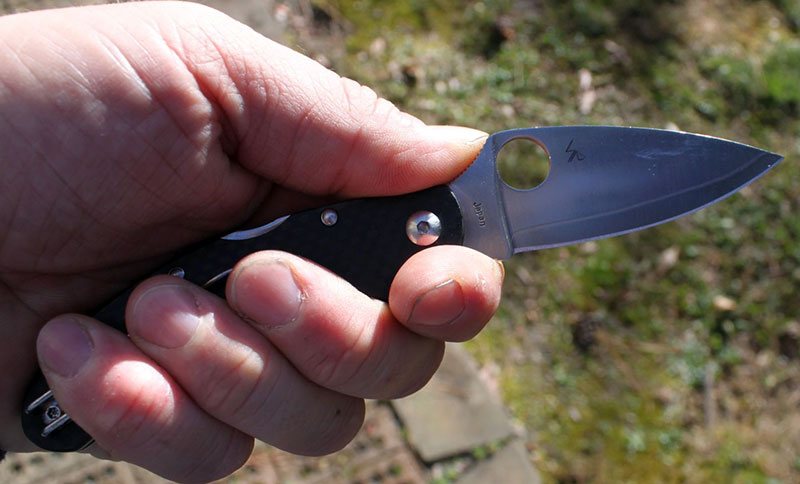
First of all, let’s talk about carry. It’s impressively light at 3.0 ounces, especially considering the stainless liners, backspacer and lockbar. This is thanks to skeletonized liners which have a series of various sized holes cut in them to reduce weight without reducing strength. The handle is relatively narrow as well due to the flat scales and lack of washers, and that deep carry wire clip has strong tension but no abrasive surface to rest on, so the knife slides in and out of the pocket with ease, but doesn’t “migrate” when you don’t want it to. Just absolute perfection when it comes to carry.
But oh! In use, the Caly 3 is just the best. Ergonomics are spot on here – Spyderco says “a great folding knife should function and feel like a natural extension of the hand” which sounds like goofy hyperbole until you get your hands around this thing. The combination of the long forward finger choil (which seems like 40% blade and 60% scale) and the steep, jimped thumb ramp lock your hand in place on this blade in a controlled forward grip. You can also do an effective pinch grip with the pivot screws and your forefinger on the thumb ramp, or a rearward grip for more leverage with your forefinger behind the trailing edge of the finger choil and your thumb on the ramp as well. The blade shape is just perfect for daily use, offering an acute tip for puncturing hard packaging, enough belly to roll cut food, and a full length flat grind that lets the Caly3 cut through cardboard like it was a zipper. It makes all other blade shapes seem superfluous.
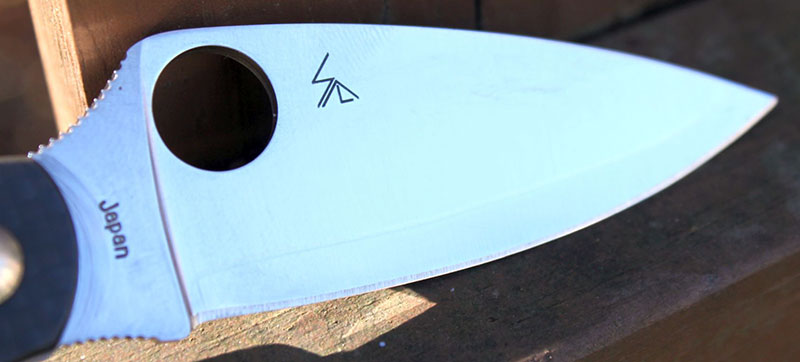
Does anything let it down in daily use? Sure, I wish the action was smoother and that it was easier to close. And not being able to break the knife down to clean it is a bummer, as are the circular scratches on the blade tang (from the lack of washers) and the random scratches on the flat sides of the outer layer (due to its softness). But it terms of how well it carries and cuts, the Caly 3 is a classic for a reason- it’s a very satisfying tool to actually use.
Alternatives
All these knives available at BladeHQ.
Discussing alternatives to a knife that’s not available any more is sort of a gray area, but let’s look at this based on dimensions and price. The Caly3 CF/ZDP originally had a $260 MSRP and it retailed for $170 according to BladeHQ. The Spyderco Native 5 is similar in dimensions (it has a 3” blade, 4” handle, weighs 2.5 ounces in lightweight form) and comes in a variety of good steels – on the low end there’s S30V and S35VN, on up through to more exotic steels like S90V, S110V, and even Maxamet – as well as upcoming rust-proof LC200N steel. The Native is a very useful knife but the design is much more bulky and basic, lacking a thumb ramp. But it does offer a four-position clip, and if you can find one the fluted carbon fiber model is one of the best looking knives Spyderco has ever made. Prices range from 108 to 184 for lightweight (S35VN to Maxamet) up to 252 for the S90V/fluted carbon fiber model.
The Chaparral is also somewhat similar to the Caly 3. While they sell the Chaparral in a variety of interesting handle variants, the carbon fiber version is most comparable, with a 2.8” leaf shaped drop point blade from full flat ground CTS-XHP steel. The Chaparral blade is very thin – only 0.08” across – for maximum slicing performance. It’s a bit lighter at 2.5 ounces, and cheaper at $140, but it doesn’t offer the exotic laminated blade of the Caly 3.

Of course, if you’re looking for other knives with ZDP-189, you’re kind of out of luck. Spyderco was the only mainstream brand that used Hitach ZDP-189 in any volume, other than Rockstead – most of who’s knives can’t be purchased for less than a thousand dollars. Kershaw experimented with ZDP-189 years ago, making several limited production versions of popular knives with ZDP-189 composite blades, like the Leek, Blur, and Shallot as well as the highly coveted Mini Cyclone. These are all nearly impossible to find, and command huge prices now, so they’re not really “users” any more. So if you want another knife with ZDP-189 it’s going to be a Japanese Spyderco – Delica, Endura, Stretch, Dragonfly, etc. And most of those are now being discontinued for 2021 as well, so ZDP-189 will soon be mostly a thing of the past. The Caly 3.5 is still in production at time of writing, with a larger 3.5” blade, but it’s unclear if it will remain so.
Outside of Spyderco, the market for high-end lockbacks with exotic steel is basically nonexistent, with a few exceptions. Swedish maker Fallkniven makes very function-driven knives with basic looks and exotic materials, like the Tre Kronor TK4 lockback, which has a 2.75” flat ground drop point in 3G powdered laminate steel – a sandwich of softer vg2 outside and super hard SG2 powdered steel inside. It’s very exotic stuff, which explains the $170 price tag on this plain looking traditional folder with Zytel handles. Only for the dedicated.
Wrap-up
I really love the Caly 3 ZDP, even if it’s a knife that’s out of touch with more modern products and doesn’t have any direct competition outside of its own brand. That’s probably why it’s a modern day classic – I can’t think of any other slicing oriented ZDP189 laminate steel lockback knives with excellent ergonomics and carbon fiber handles. That’s just kind of the Spyderco idea; they’ve spent many years focusing on just doing their own thing, at least partially. They follow market trends, sure, but they dedicate some of their energy to just selling knife nerd knives to knife nerds. I mentioned above that they’re discontinuing the mainstream ZDP-189 knives- but don’t worry, they’re being replace by K390 variants, another super high carbon/high molybdenum blend steel that will hold an edge forever.
A more interesting question would be – how would I update the Caly 3 to be a more modern product? Well, it would benefit from being able to be disassembled and maintained – the flush fitting body screws like the PM2 uses would be nice. A set of phosphor bronze washers between the liners and the blade would make the knife only microscopically thicker but would make it much smoother to open and close. Maybe they could switch it over to the compression lock too while they’re fiddling. But this is all pie in the sky, as Spyderco has moved on from this product, and so now will this review.
- Best-in-show ergonomics, crazy laminated blade steel provides unique benefits and looks, good-at-everything blade shape, incredible fit and finish, great clip and scales.
- Slow to open and close, lack of washers leave scratches on tang of blade, modern super steels achieve same results without the complicated laminate, outer edge of laminate prone to scratching, cannot disassemble due to pinned construction
Spyderco Caly 3
Quality/Performance - 86%
Value for Money - 83%
85%
The Spyderco Caly 3 may be out of date but not obsolete - it's still an absolute joy to operate.





